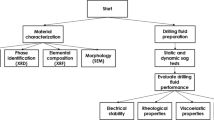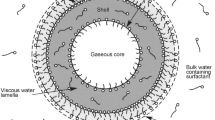Abstract
The application of oil-based drilling fluids in high temperature deep well drilling and the other complex well drilling process has been severely restricted due to the limited types and poor high-temperature high-pressure (HTHP) fluid loss (FL) control capability of fluid loss control additives (FLCAs). Aiming at the issue, a kind of slightly amphiphilic polymer microspheres, i.e., poly (acrylamide-co-divinylbenzene) (PACD) microspheres, with mean diameter 3.2 μm and polydispersity 1.82, were selected as the FLCA for oil-based drilling fluids in the study. The performance of PACD microspheres in terms of FL control and the structure of filter cake was compared with the traditional additives including oxidized asphalt and nano-CaCO3. The results showed that PACD microspheres have superior HTHP FL control capability. The HTHP FL of oil-based drilling fluids at 180 °C can be controlled within 10 mL as the addition of PACD microspheres was kept at 5 kg/m3. The FL control mechanism of PACD microspheres was analyzed based on the physical properties of PACD microspheres, the rheological properties of oil-based drilling fluids and the macro-appearance and microstructure of the filter cake. It was concluded that the superior HTHP FL control capability of PACD microspheres is due to the finite deformation property and the slight amphipathy of the microspheres.






Similar content being viewed by others
References
Ikram, R.; Jan, B.M.; Sidek, A.: Utilization of eco-friendly waste generated nanomaterials in water-based drilling fluids; state of the art review. Materials (2021). https://doi.org/10.3390/ma14154171
Ghalambor, A., Ashrafizadeh, S. N., Nasiri, M. Z.: Effect of Basic Parameters on Viscosity in Synthetic-Based Drilling Fluids. In: SPE International Symposium and Exhibition on Formation Damage Control. Society of Petroleum Engineers, (2008). https://doi.org/10.2118/112276-MS
Karagüzel, C.; Çetinel, T.; Boylu, F., et al.: Activation of (Na, Ca)-bentonites with soda and MgO and their utilization as drilling mud. Appl. Clay Sci. 48(3), 398–404 (2010). https://doi.org/10.1016/j.clay.2010.01.013
Zhou, D.; Zhang, Z.; Tang, J., et al.: Applied properties of oil-based drilling fluids with montmorillonites modified by cationic and anionic surfactants. Appl. Clay Sci. 121, 1–8 (2016). https://doi.org/10.1016/j.clay.2015.12.015
Zhuang, G.; Zhang, Z.; Fu, M., et al.: Comparative study on the use of cationic-nonionic-organo-montmorillonite in oil-based drilling fluids. Appl. Clay Sci. 116, 257–262 (2015). https://doi.org/10.1016/j.clay.2015.04.004
Przepasniak, A. M., Clark, P. E.: Polymer loss in filter cakes. In: SPE Formation Damage Control Conference. Society of Petroleum Engineers, (1998). https://doi.org/10.2118/39461-MS
Waldmann, A.T.; Martins, A.L.; Aragao, A.F.: Predicting and monitoring fluid invasion in exploratory drilling. SPE Drill. Complet. 20(4), 268–275 (2005). https://doi.org/10.2118/86497-PA
Aston, M., Mihalik, P., Tunbridge, J.: Towards zero fluid loss oil based muds. In: SPE Annual Technical Conference and Exhibition. Society of Petroleum Engineers. https://doi.org/10.2118/77446-MS
Wyant, R.E.; Reed, R.; Sifferman, T.R.: Dynamic fluid-loss measurement of oil-mud additives. SPE Drill. Eng. 2(1), 63–74 (2002). https://doi.org/10.2118/14246-PA
Amanullah, M.; Ramasamy, J.; Al-Arfaj, M.K.: Application of an indigenous eco-friendly raw material as fluid loss additive. J. Petrol. Sci. Eng. 139, 191–197 (2016). https://doi.org/10.1016/j.petrol.2015.12.023
Coates, J. A., Farrar, J. M. (1990). U.S. Patent No. 4,941,983.
Firth Jr, W. C. (1989). U.S. Patent No. 4,889,645.
Ma, C., Li, L., Lu, H.: Study on the Effect of Humic Acid Acetamide on the Rheological Properties of Diesel Oil-Based Drilling Fluids. In: Applied Mechanics and Materials (Vol. 620, pp. 449–452). Trans Tech Publications (2014). https://doi.org/10.4028/www.scientific.net/AMM.620.449
Connell, D. L., Gradwell, A. J. (1987). U.S. Patent No. 4,671,883.
Patel, A. D., Mettath, S., Stamatakis, E. (2013). U.S. Patent No. 8,524,640.
Patel, A. D., Mettath, S., Stamatakis, E. (2014). U.S. Patent No. 8,871,690.
Fan, J.; Zhu, H.; Li, R.: Montmorillonite modified by cationic and nonionic surfactants as high-performance fluid-loss-control additive in oil-based drilling fluids. J. Dispersion Sci. Technol. 36(4), 569–576 (2015). https://doi.org/10.1080/01932691.2014.917052
Dias, F.T.G.; Souza, R.R.; Lucas, E.F.: Influence of modified starches composition on their performance as fluid loss additives in invert-emulsion drilling fluids. Fuel 140, 711–716 (2015). https://doi.org/10.1016/j.fuel.2014.09.074
Patel, A. D., McGlothlin, R. E., Bleier, R. D. (1993). U.S. Patent No. 5,189,012.
Cowan, J. C., House, R. F., Granquist, V. M. (1990). U.S. Patent No. 4,956,104.
Ballard, D. A. (2010). U.S. Patent No. 7,786,052.
Dams, Rudi, Opstal, Tom. (2010). European Patent EP2463349.
Zhong, H.W.: Research and application progress of oil-based drilling fluid at home and abroad. Fault-Block Oil & Gas Field 4, 034 (2011)
Der Linden Bart Hendricus Jozef Van. (2004). WO2004013251 A1.
Van de Peer, D., D'haese, F. C., Dams, R. J. (2013). U.S. Patent No. 8,343,895.
Guichard, B., Valenti, A., Friedheim, J. E.: An organosoluble polymer for outstanding fluid loss control with minimum formation damage. In: European Formation Damage Conference. Society of Petroleum Engineers, (2007).
Chen, D.J.; Wei, H.M.; Tie, C.J., et al.: A review of research on fluid loss control agents for drilling fluids. Oilfield Chem. 30(2), 295–300 (2013)
Zhao, Y., Wang, M. G.: Research progress of fluid loss control agents for oil-based drilling fluids at home and abroad. Applied Chemical Industry, (2014).
Wang, X.G.; Yang, X.H.; Wang, L., et al.: Research and application progress of high temperature resistant drilling fluid fluid loss agent at home and abroad. Sino-Global Energy 14(4), 37–42 (2009)
Paul Way, Phillip Rice, Gerald Meeten, Louise Bailey. (2006). WO2006040578 A1.
He, J.; Sun, Y.; Feng, X.: Preparation of uniform poly (Acrylamide-co-DVB) microspheres in a low toxicity solvent by dispersion polymerization. Aust. J. Chem. 68(8), 1276–1281 (2015). https://doi.org/10.1071/CH14670
Zhong, H.Y.; Shen, G.C.; Qiu, Z.S.: Minimizing the HTHP filtration loss of oil-based drilling fluid with swellable polymer microspheres. J. Petrol. Sci. Eng. 172, 411–424 (2019). https://doi.org/10.1016/j.petrol.2018.09.074
Chen, Y.R.; Wu, R.N.; Zhou, J.: A novel hyper-cross-linked polymer for high-efficient fluid-loss control in oil-based drilling fluids. Colloids Surf. A-physicochem. Eng. Aspects (2021). https://doi.org/10.1016/j.colsurfa.2021.127004
Huang, W.A.; Qiu, Z.S.; Xu, J.F., et al.: Development and application of ultra-high temperature salt-resistant polymer fluid loss agent. J. China Univ. Petrol.Natural Sci. Edition 35(1), 155–158 (2011)
Wang, Y.X.; Chen, Y.L.; Song, J.T.: Preparation of new zwitterionic AM-AMPS copolymer fluid loss agent by Hofmann method. Geol. Sci. Technol. Inf. 27(4), 107–110 (2008)
Li, R.; Yu, L.M.; Gao, B.J.: Progress in the preparation and application of polymer microspheres. Guangzhou Chem. Ind. 39(4), 14–16 (2011)
Wang, J.L.; Zheng, Z.J.; Zhang, L.J., et al.: Research progress of polymer microsphere materials for oilfields. Progr. Fine Petrochem. Ind. 13(2), 1–4 (2012)
And, W.E.S.; Lamb, H.H.: Synthesis of nanostructured titania powders via hydrolysis of titanium isopropoxide in supercritical carbon dioxide. Langmuir 19(7), 2987–2994 (2003)
Feng, H.L.; Yan, E.W.; Zhang, J., et al.: A controlled morphology of polymeric nanocapsules via the density of surface vinyl group for the precipitation polymerization. Polymer 51(17), 4511–4520 (2013). https://doi.org/10.1016/j.polymer.2013.06.035
Author information
Authors and Affiliations
Corresponding author
Ethics declarations
Conflict of interest
The authors declare that they have no known competing financial interests or personal relationships that could have appeared to influence the work reported in this paper.
Rights and permissions
About this article
Cite this article
Chen, F., Zhang, L., He, J. et al. Slightly Amphiphilic Polymer Microspheres as an HTHP Fluid Loss Control Additive for Oil-Based Drilling Fluid. Arab J Sci Eng 48, 117–128 (2023). https://doi.org/10.1007/s13369-022-06781-x
Received:
Accepted:
Published:
Issue Date:
DOI: https://doi.org/10.1007/s13369-022-06781-x




